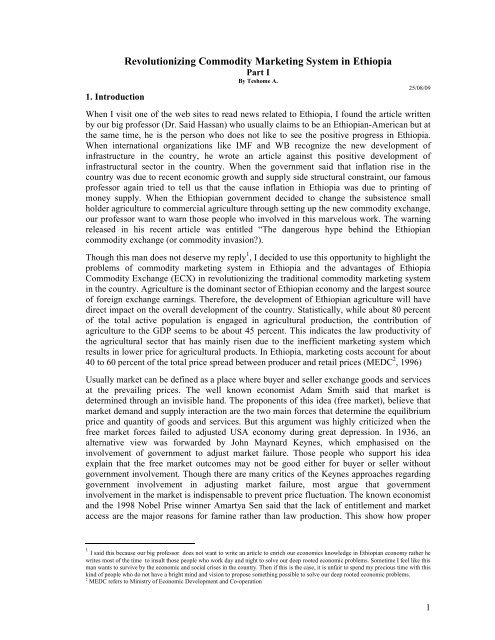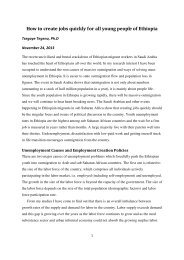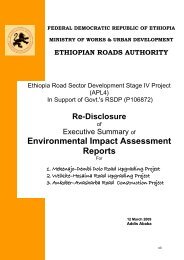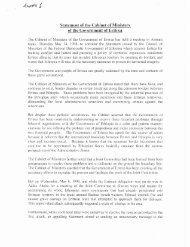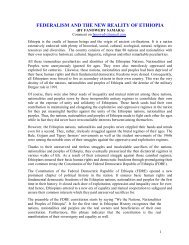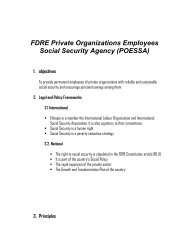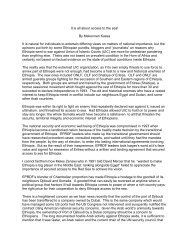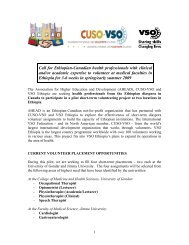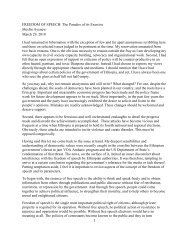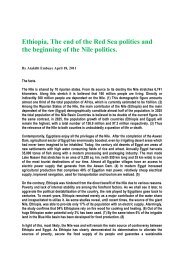Revolutionizing Commodity Marketing System in Ethiopia
Revolutionizing Commodity Marketing System in Ethiopia
Revolutionizing Commodity Marketing System in Ethiopia
Create successful ePaper yourself
Turn your PDF publications into a flip-book with our unique Google optimized e-Paper software.
1. Introduction<br />
<strong>Revolutioniz<strong>in</strong>g</strong> <strong>Commodity</strong> <strong>Market<strong>in</strong>g</strong> <strong>System</strong> <strong>in</strong> <strong>Ethiopia</strong><br />
Part I<br />
By Teshome A.<br />
25/08/09<br />
When I visit one of the web sites to read news related to <strong>Ethiopia</strong>, I found the article written<br />
by our big professor (Dr. Said Hassan) who usually claims to be an <strong>Ethiopia</strong>n-American but at<br />
the same time, he is the person who does not like to see the positive progress <strong>in</strong> <strong>Ethiopia</strong>.<br />
When <strong>in</strong>ternational organizations like IMF and WB recognize the new development of<br />
<strong>in</strong>frastructure <strong>in</strong> the country, he wrote an article aga<strong>in</strong>st this positive development of<br />
<strong>in</strong>frastructural sector <strong>in</strong> the country. When the government said that <strong>in</strong>flation rise <strong>in</strong> the<br />
country was due to recent economic growth and supply side structural constra<strong>in</strong>t, our famous<br />
professor aga<strong>in</strong> tried to tell us that the cause <strong>in</strong>flation <strong>in</strong> <strong>Ethiopia</strong> was due to pr<strong>in</strong>t<strong>in</strong>g of<br />
money supply. When the <strong>Ethiopia</strong>n government decided to change the subsistence small<br />
holder agriculture to commercial agriculture through sett<strong>in</strong>g up the new commodity exchange,<br />
our professor want to warn those people who <strong>in</strong>volved <strong>in</strong> this marvelous work. The warn<strong>in</strong>g<br />
released <strong>in</strong> his recent article was entitled “The dangerous hype beh<strong>in</strong>d the <strong>Ethiopia</strong>n<br />
commodity exchange (or commodity <strong>in</strong>vasion).<br />
Though this man does not deserve my reply 1 , I decided to use this opportunity to highlight the<br />
problems of commodity market<strong>in</strong>g system <strong>in</strong> <strong>Ethiopia</strong> and the advantages of <strong>Ethiopia</strong><br />
<strong>Commodity</strong> Exchange (ECX) <strong>in</strong> revolutioniz<strong>in</strong>g the traditional commodity market<strong>in</strong>g system<br />
<strong>in</strong> the country. Agriculture is the dom<strong>in</strong>ant sector of <strong>Ethiopia</strong>n economy and the largest source<br />
of foreign exchange earn<strong>in</strong>gs. Therefore, the development of <strong>Ethiopia</strong>n agriculture will have<br />
direct impact on the overall development of the country. Statistically, while about 80 percent<br />
of the total active population is engaged <strong>in</strong> agricultural production, the contribution of<br />
agriculture to the GDP seems to be about 45 percent. This <strong>in</strong>dicates the law productivity of<br />
the agricultural sector that has ma<strong>in</strong>ly risen due to the <strong>in</strong>efficient market<strong>in</strong>g system which<br />
results <strong>in</strong> lower price for agricultural products. In <strong>Ethiopia</strong>, market<strong>in</strong>g costs account for about<br />
40 to 60 percent of the total price spread between producer and retail prices (MEDC 2 , 1996)<br />
Usually market can be def<strong>in</strong>ed as a place where buyer and seller exchange goods and services<br />
at the prevail<strong>in</strong>g prices. The well known economist Adam Smith said that market is<br />
determ<strong>in</strong>ed through an <strong>in</strong>visible hand. The proponents of this idea (free market), believe that<br />
market demand and supply <strong>in</strong>teraction are the two ma<strong>in</strong> forces that determ<strong>in</strong>e the equilibrium<br />
price and quantity of goods and services. But this argument was highly criticized when the<br />
free market forces failed to adjusted USA economy dur<strong>in</strong>g great depression. In 1936, an<br />
alternative view was forwarded by John Maynard Keynes, which emphasised on the<br />
<strong>in</strong>volvement of government to adjust market failure. Those people who support his idea<br />
expla<strong>in</strong> that the free market outcomes may not be good either for buyer or seller without<br />
government <strong>in</strong>volvement. Though there are many critics of the Keynes approaches regard<strong>in</strong>g<br />
government <strong>in</strong>volvement <strong>in</strong> adjust<strong>in</strong>g market failure, most argue that government<br />
<strong>in</strong>volvement <strong>in</strong> the market is <strong>in</strong>dispensable to prevent price fluctuation. The known economist<br />
and the 1998 Nobel Prise w<strong>in</strong>ner Amartya Sen said that the lack of entitlement and market<br />
access are the major reasons for fam<strong>in</strong>e rather than law production. This show how proper<br />
1 I said this because our big professor does not want to write an article to enrich our economics knowledge <strong>in</strong> <strong>Ethiopia</strong>n economy rather he<br />
writes most of the time to <strong>in</strong>sult those people who work day and night to solve our deep rooted economic problems. Sometime I feel like this<br />
man wants to survive by the economic and social crises <strong>in</strong> the country. Then if this is the case, it is unfair to spend my precious time with this<br />
k<strong>in</strong>d of people who do not have a bright m<strong>in</strong>d and vision to propose someth<strong>in</strong>g possible to solve our deep rooted economic problems.<br />
2 MEDC refers to M<strong>in</strong>istry of Economic Development and Co-operation<br />
1
function<strong>in</strong>g of the market plays the major role <strong>in</strong> reduc<strong>in</strong>g fam<strong>in</strong>e or poverty through<br />
distribut<strong>in</strong>g food from surplus areas to deficit areas.<br />
In this regard, s<strong>in</strong>ce 1960 <strong>Ethiopia</strong>n governments have been attempt<strong>in</strong>g to set up appropriate<br />
<strong>in</strong>stitutions that can facilitate the proper function<strong>in</strong>g of market<strong>in</strong>g system <strong>in</strong> the country.<br />
However, most of these efforts were not successful due to various reasons. To present my idea<br />
<strong>in</strong> a clear and understandable manner, I will divide my article <strong>in</strong>to two parts: The first part<br />
focuses on the ma<strong>in</strong> activities that have been undertaken <strong>in</strong> improv<strong>in</strong>g the agricultural<br />
market<strong>in</strong>g system <strong>in</strong> the country. In this part, the article reviews policy direction used to<br />
improve the commodity trad<strong>in</strong>g system. In addition to this, it identifies the major problems of<br />
the traditional commodity market<strong>in</strong>g system <strong>in</strong> the country. The second part of this article<br />
discusses the concepts and importance of commodity exchange market <strong>in</strong> <strong>Ethiopia</strong>n context.<br />
Further it attempts to expla<strong>in</strong> the detail work undertaken to set up an effective commodity<br />
exchange market <strong>in</strong> <strong>Ethiopia</strong>. F<strong>in</strong>ally this article identifies the major challenge that encounters<br />
ECX <strong>in</strong> revolutionis<strong>in</strong>g the commodity market<strong>in</strong>g system.<br />
Part I has three sections <strong>in</strong>clud<strong>in</strong>g <strong>in</strong>troduction. The second section ma<strong>in</strong>ly reviews the<br />
government’s efforts <strong>in</strong> improv<strong>in</strong>g agricultural market<strong>in</strong>g system dur<strong>in</strong>g the last two regimes<br />
and the EPRDF government. The last section identifies the major problems prevail<strong>in</strong>g <strong>in</strong> the<br />
commodity market<strong>in</strong>g system <strong>in</strong> the country<br />
2. Review of commodity market<strong>in</strong>g system <strong>in</strong> <strong>Ethiopia</strong><br />
<strong>Market<strong>in</strong>g</strong> <strong>in</strong>cludes assembl<strong>in</strong>g, stor<strong>in</strong>g, transport<strong>in</strong>g, grad<strong>in</strong>g, standardization, f<strong>in</strong>anc<strong>in</strong>g, risk<br />
tak<strong>in</strong>g, etc. The absence of any of these activities dur<strong>in</strong>g commodity market<strong>in</strong>g process would<br />
<strong>in</strong>fluence the outcome of price and quantity of agricultural products. <strong>Ethiopia</strong>n government<br />
started to give attention to the development of agricultural sector s<strong>in</strong>ce the second five year<br />
development plan. The first five year development plan (1957-1963) was focused more on the<br />
development of <strong>in</strong>frastructure and <strong>in</strong>dustry <strong>in</strong> the country. The second five year development<br />
plan (1963-1967) partly gave attention to the development of agricultural sector. S<strong>in</strong>ce 1960<br />
various efforts were exerted to improve the commodity market<strong>in</strong>g system based on the<br />
economic policy implemented <strong>in</strong> respective regimes. Except the military government, both<br />
regimes (Monarchy and EPRDF government) applied relatively market base economic system<br />
which gave more opportunity to the market forces to determ<strong>in</strong>e the price of agricultural<br />
productions. Comparatively the current government (EPRDF government) <strong>in</strong>volvement <strong>in</strong><br />
agricultural market is m<strong>in</strong>imal as compared to the Monarchy government. The next three sub<br />
sections briefly expla<strong>in</strong> the <strong>in</strong>stitutional establishments and addition measures exerted to<br />
improve commodity market<strong>in</strong>g system <strong>in</strong> the country.<br />
2.1 <strong>Commodity</strong> market<strong>in</strong>g system dur<strong>in</strong>g Monarchy period<br />
Dur<strong>in</strong>g the Monarchy period the country’s economy was dom<strong>in</strong>ated partly by the private<br />
sector with more foreign <strong>in</strong>vestors as compared to the domestic <strong>in</strong>vestors <strong>in</strong> the agricultural<br />
sector. The government <strong>in</strong>tervention <strong>in</strong> the agricultural market was m<strong>in</strong>imal till 1960. In 1950<br />
the government established <strong>Ethiopia</strong> Gra<strong>in</strong> Board (EGB). The EGB functioned as a regulatory<br />
body with primary emphasis on export licens<strong>in</strong>g, quality control, and overseas market<br />
<strong>in</strong>telligence. It did not hold stocks or <strong>in</strong>volved <strong>in</strong> sell<strong>in</strong>g or buy<strong>in</strong>g of agricultural products.<br />
But <strong>in</strong> 1960 the government had taken steps to improve the commodity market<strong>in</strong>g system by<br />
establish<strong>in</strong>g the <strong>Ethiopia</strong>n Gra<strong>in</strong> Corporation (EGC), the National Coffee Board and Cooperative<br />
societies. The Corporation which was established <strong>in</strong> 1960 was empowered to<br />
purchase, grade, process and transport agricultural product. With a network of storage<br />
2
facilities, it was thought that the corporation would be able to purchase all offered marketable<br />
surplus and <strong>in</strong>tervene <strong>in</strong> the market wherever necessary. The primary role of the EGC was to<br />
promote the gra<strong>in</strong> export to boost the foreign reserves. In addition to this the Co-operatives<br />
established and easily obta<strong>in</strong>ed credit from banks and thus avoided the sell<strong>in</strong>g of the product<br />
at the time of the post harvest period.<br />
The Chilalo Agricultural Development Unit (CADU) which was started <strong>in</strong> 1967 also applied<br />
various 3 commodity market<strong>in</strong>g mechanisms to encourage farmers to use modern <strong>in</strong>puts for<br />
improv<strong>in</strong>g productivity <strong>in</strong> project areas. But all the methods used by CADU could not realize<br />
their price stabilization objective due to the challenges encountered <strong>in</strong> the market<strong>in</strong>g<br />
operations. Some of the challenges were lack of farmer will<strong>in</strong>gness to work with new<br />
CADU’s pric<strong>in</strong>g method, gra<strong>in</strong> importation by EGC which reduced gra<strong>in</strong> local price and<br />
f<strong>in</strong>ancial loss <strong>in</strong>curred by CADU. In the same way the <strong>in</strong>stitution which established by the<br />
government (EGC) suffered from short com<strong>in</strong>gs related to shortage of work<strong>in</strong>g capital, the<br />
lack of a government price policy and <strong>in</strong>sufficient market <strong>in</strong>formation and also it was unable<br />
to generate enough profit to cover its adm<strong>in</strong>istrative overhead costs. At the end of the 1975<br />
the Corporation took only 5 percent of the total gra<strong>in</strong> market (Webb P. et. al. 1992).Around<br />
90 percent of the gra<strong>in</strong> was supplied by private traders.<br />
The market supply by the small holder farmers was also very law because of households<br />
payment of rent <strong>in</strong> k<strong>in</strong>d to land owners. Dur<strong>in</strong>g the period 1960-1974, the commodity market<br />
price was determ<strong>in</strong>ed by market forces. In addition, the market<strong>in</strong>g system was free from<br />
government control. However, the government controlled the commodity market through two<br />
mechanisms: large ownership of land with very limited property right; and control of<br />
<strong>in</strong>ternational trade through state enterprises. Even dur<strong>in</strong>g the drought period <strong>in</strong> 1973 when<br />
thousands of people were dy<strong>in</strong>g from hunger there was no shortage of food gra<strong>in</strong>s <strong>in</strong> Addis<br />
Ababa or other major urban areas. It was clear that the market<strong>in</strong>g system did not efficiently<br />
reallocate surplus to deficit areas. In addition the commodity market failure can be seen by the<br />
high fluctuation of price with<strong>in</strong> and between the years (Holmberg, 1977).<br />
2.2 <strong>Commodity</strong> market<strong>in</strong>g system dur<strong>in</strong>g Military period<br />
The Military (Dergue) government which came to power <strong>in</strong> 1974 by depos<strong>in</strong>g the Monarchy<br />
government, officially declared its socialist economic policy. In 1975, the government<br />
nationalized most of the private assets and at the same time restricted private sector<br />
<strong>in</strong>volvement <strong>in</strong> the agricultural sector. Such measures by the government reduced the<br />
agricultural production which affected gra<strong>in</strong> supply <strong>in</strong> urban areas. This situation brought<br />
about an <strong>in</strong>crease <strong>in</strong> gra<strong>in</strong> price <strong>in</strong> major urban areas. To control the price and provide enough<br />
gra<strong>in</strong> supply to urban areas, the Military government established Agricultural <strong>Market<strong>in</strong>g</strong><br />
Corporation (AMC 4 ).The new Corporation absorbed the function of the EGC and began<br />
operation with a special focus on gra<strong>in</strong> procurement of public distribution and on cereal price<br />
stabilization. The government identified the follow<strong>in</strong>g objectives <strong>in</strong> its gra<strong>in</strong> market project<br />
proposal.<br />
Assure stable producer and consumer prices;<br />
Ma<strong>in</strong>ta<strong>in</strong> adequate producer <strong>in</strong>centives;<br />
Reduce market<strong>in</strong>g marg<strong>in</strong>s through greater efficiency and reduced risks and<br />
profits;<br />
Assure an adequate food supply <strong>in</strong> all parts of the country<br />
3 Dur<strong>in</strong>g the 1967-1973 period CADU followed three different wheat market<strong>in</strong>g strategies(John M.Cohen,1987)<br />
4 The Agricultural <strong>Market<strong>in</strong>g</strong> Corporation (AMC) was created <strong>in</strong> 1976, <strong>in</strong>itially with World Bank support, to buy gra<strong>in</strong> from farmers and sell<br />
to urban consumers and state organizations.<br />
3
Further traders were forced to sell a portion of their supplies to the AMC at specified prices.<br />
Farmers had to deliver between 10 to 50 percent of their gra<strong>in</strong> harvest as a quota to the AMC.<br />
In the late 1970s, Peasant Associations were obliged to deliver a m<strong>in</strong>imum of 10,000<br />
kilogram of their annual product to the AMC at fixed prices. In 1981, this quota was raised to<br />
15,000 kilogram without a concomitant <strong>in</strong>crease <strong>in</strong> production prices. The government's price<br />
controls and the AMC's operations had led to the development of different pric<strong>in</strong>g systems at<br />
various levels aga<strong>in</strong>st government objectives. Just to show my readers about this price<br />
difference I used the table below which displays the crops price set by AMC price and the<br />
market price <strong>in</strong> two selected areas <strong>in</strong> the country. Dur<strong>in</strong>g July 1985-June 1986, the average<br />
AMC price for Barley was Birr 28 per qu<strong>in</strong>tal when the same product was sold at Birr 61 <strong>in</strong><br />
Gojjam and Birr 106 <strong>in</strong> Wello. This implies that AMC price was 46 percent and 26 percent<br />
lower than Gojjam and Wello Barley market price.<br />
Table 1: Comparison of AMC prices to mean nom<strong>in</strong>al retail prices, Gojjam and Wello<br />
<strong>in</strong> July 1985-June 1986 and January 1988<br />
(<strong>in</strong> Eth. Birr)<br />
Crop AMC Farmgate price Gojjam Wello<br />
July1985<br />
June 1986<br />
January<br />
1998<br />
July1985<br />
June 1986<br />
January<br />
1998<br />
July1985<br />
June 1986<br />
Barley 28 30 61 56 106 68<br />
Sorghum 23 25 55 44 118 85<br />
January<br />
1998<br />
Teff 45 48 77 72 157 129<br />
Wheat 34 36 79 69 118 88<br />
Source: Webb P. et. al., 1992<br />
One can see <strong>in</strong> the above table the wide gap <strong>in</strong> price marg<strong>in</strong> between the AMC price and<br />
market prices for all crop production: Sorgum, Teff and wheat. Such market price marg<strong>in</strong><br />
encourages the farmers to sell their product to the market than <strong>in</strong> AMC. In order to strengthen<br />
its control over gra<strong>in</strong> movement <strong>in</strong> the whole country the government set up roadblocks at the<br />
entrance to all town or large villages. But all these efforts could not stabilize the gra<strong>in</strong> price <strong>in</strong><br />
the country. The desperate military government had <strong>in</strong>tensified its non- market action to<br />
control the ris<strong>in</strong>g commodity price. For <strong>in</strong>stance the government executed 5 seven merchants<br />
for alleged hoard<strong>in</strong>g and overpric<strong>in</strong>g of gra<strong>in</strong> (Holmberg, 1977).<br />
All the government non market measures like quota and price fix<strong>in</strong>g distort the proper<br />
function<strong>in</strong>g of the market through; (1) depress<strong>in</strong>g rural <strong>in</strong>comes; (2) transferr<strong>in</strong>g resources<br />
from rural households to a relatively small group of urban households through artificially<br />
cheap food prices; and (3) depress<strong>in</strong>g cereals production <strong>in</strong> <strong>Ethiopia</strong>. In October 1990 the<br />
Military government conducted new reform program by remov<strong>in</strong>g quota and allow<strong>in</strong>g private<br />
sector to get <strong>in</strong>volved <strong>in</strong> the agricultural sector. But these were not the solution for solv<strong>in</strong>g the<br />
core problems of the commodity market<strong>in</strong>g system <strong>in</strong> the country. Whatever the case these<br />
reform measures were a great relief for highly controlled commodity market system <strong>in</strong> the<br />
country. Dur<strong>in</strong>g 1974-1990, the regime severely damaged the market base trad<strong>in</strong>g system<br />
which was started dur<strong>in</strong>g the Monarchy government. Various studies revealed that the average<br />
growth rate of agriculture dur<strong>in</strong>g this period was 1 percent as compared to around 3 percent of<br />
5 In at least one case a merchant was executed for hoard<strong>in</strong>g no more than 200 qu<strong>in</strong>tals of gra<strong>in</strong>s(Holmberg, 1977)<br />
4
the population growth. Hence, the government land reform without the proper commodity<br />
market<strong>in</strong>g system could not br<strong>in</strong>g susta<strong>in</strong>able agricultural transformation <strong>in</strong> the country.<br />
2.3 <strong>Commodity</strong> market<strong>in</strong>g system dur<strong>in</strong>g EPRDF government<br />
Follow<strong>in</strong>g the fall of the Dergue regime, a transitional government embraced market oriented<br />
economic policies. The government has undertaken a wide range reform <strong>in</strong> agricultural sector.<br />
This reform <strong>in</strong>cluded elim<strong>in</strong>ation of official fixed prices, removal of compulsory delivery<br />
quotas and abolition of gra<strong>in</strong> ration<strong>in</strong>g to urban consumer. All controls on <strong>in</strong>terregional gra<strong>in</strong><br />
movement were lifted and the private sector was permitted to operate <strong>in</strong> a free market<br />
environment. In 1992, the AMC was downsized substantially and renamed the <strong>Ethiopia</strong>n<br />
Gra<strong>in</strong> Trad<strong>in</strong>g Enterprise (EGTE). The role of the EGTE was revised to stabilize producer and<br />
consumer prices and ma<strong>in</strong>ta<strong>in</strong> buffer stocks. The withdrawal of the government from<br />
agricultural market <strong>in</strong> the early 1990s provided a much needed boost to agricultural<br />
production and, given its large share of GDP, to the overall economy (Anderson K. et. al,<br />
2009)<br />
However, the new market based economic policy was decided <strong>in</strong> the country without<br />
sufficient <strong>in</strong>stitutional arrangement that was required for the smooth function<strong>in</strong>g of the<br />
market. We need responsible and capable <strong>in</strong>stitutions that can provide necessary <strong>in</strong>formation<br />
and trad<strong>in</strong>g regulation for market actors to enable them to work with less risk. At the same<br />
time, rather than to strength the EGTE capacity by human and f<strong>in</strong>ancial resources for the<br />
purpose of price stabilization, the current government left the market alone to get adjusted by<br />
itself (by <strong>in</strong>visible hand). In 1995/96 due to an <strong>in</strong>crease <strong>in</strong> cultivated land size 6 , more<br />
fertilizers utilization and better weather conditions, the country was able to register higher<br />
crop production. In December (1995/96), the Central Statistical Authority (CSA) and FAO<br />
<strong>in</strong>dependently forecasted that food gra<strong>in</strong> production (cereals and pulses) would be 20% and<br />
27% higher, respectively, than that of the previous year 1994/95) (MEDC, 1996).<br />
With the absence of efficient and proper commodity market<strong>in</strong>g system <strong>in</strong> the country, such<br />
surplus production had reduced the market price of most agricultural commodities which<br />
directly affected the life of rural poor people. For <strong>in</strong>stance maize prices <strong>in</strong> surplus-produc<strong>in</strong>g<br />
areas have been particularly depressed, fall<strong>in</strong>g as low as 55% to 70% of their five-year<br />
average levels <strong>in</strong> parts of Oromia and Southern regions (ibid). In order to <strong>in</strong>crease the price of<br />
agricultural price, the government set the m<strong>in</strong>imum price 7 through EGTE and tried to<br />
purchase the surplus product. In addition to this, the agreement was reached with donor<br />
agency like EU to buy gra<strong>in</strong> production from the domestic market than import<strong>in</strong>g the gra<strong>in</strong><br />
from abroad. But all these government efforts could not prevent the price from decal<strong>in</strong>g<br />
bellow the cost of production. The ma<strong>in</strong> problem was the limited f<strong>in</strong>ancial capacity of EGTE<br />
to buy more products from the market. Comb<strong>in</strong>ed donor and EGTE maize purchases have<br />
amounted to less than 8 percent of the estimated marketed maize output. This was not<br />
sufficient to restore maize prices close to their average levels <strong>in</strong> many parts of the country.<br />
These have clear implications for farmer plant<strong>in</strong>g decisions and gra<strong>in</strong> production <strong>in</strong> the<br />
follow<strong>in</strong>g years.<br />
In related development after four years <strong>in</strong> 2000, surplus gra<strong>in</strong> production was recorded <strong>in</strong><br />
some parts of the country. Sadly, such surplus production aga<strong>in</strong> reduced the market price <strong>in</strong><br />
the surplus areas. For <strong>in</strong>stance wheat price <strong>in</strong> Gode town plummeted, from 260 Birr per 100kg<br />
6 In 1995/96 the cultivated land area <strong>in</strong>creased by 10 percent as compared to the year 1994/95.<br />
7 In 1995/06, EGTE set m<strong>in</strong>imum price to help farmer: 70 birr for maize and 116 birr for wheat.<br />
5
<strong>in</strong> May 1999 to 90 Birr <strong>in</strong> June 2000, a 65 percent price reduction. In the same way <strong>in</strong><br />
Nekemte, wholesale price for maize dropped by 50 percent from mid 1999 to the same period<br />
<strong>in</strong> 2000 (UN, 2002). Though government has occasionally used public enterprise to <strong>in</strong>tervene<br />
<strong>in</strong> commodity markets to ensure price stability, this government effort could not control the<br />
volatility of price that affect the <strong>in</strong>centives of the farmers to use more modern technology.<br />
The government’s desire to transform the agricultural sector through Participatory<br />
Demonstration and Tra<strong>in</strong><strong>in</strong>g Extension <strong>System</strong> (PDTES) has been challenged by the absence<br />
of proper commodity market<strong>in</strong>g system <strong>in</strong> the country. The absence of strong <strong>in</strong>stitution that<br />
can stabilize commodity price <strong>in</strong> the country is discourag<strong>in</strong>g many farmers who were<br />
<strong>in</strong>volved <strong>in</strong> the new extension package program 8 . The ma<strong>in</strong> source of this problem is the<br />
government decision to downsize EGTE which underm<strong>in</strong>e the capacity of the Enterprise to<br />
stabilize price. The other <strong>in</strong>terest<strong>in</strong>g th<strong>in</strong>g, EGTE has been <strong>in</strong>volv<strong>in</strong>g <strong>in</strong> gra<strong>in</strong> export despite<br />
its failure <strong>in</strong> stabiliz<strong>in</strong>g local gra<strong>in</strong> price <strong>in</strong> the country. The problem of <strong>in</strong>frastructure and lack<br />
of clear vision <strong>in</strong> the agricultural output market<strong>in</strong>g system of the country prevented EGTE<br />
from accomplish<strong>in</strong>g its objective of price stabilization (Alemu, 2005).Though there have been<br />
many promis<strong>in</strong>g progresses recorded by the current government, the absence of effective<br />
commodity market<strong>in</strong>g system and lack of timely <strong>in</strong>formation flow substantially h<strong>in</strong>dered the<br />
expected structural transformation of agricultural sector <strong>in</strong> the country.<br />
3. Problems of commodity market<strong>in</strong>g system <strong>in</strong> <strong>Ethiopia</strong><br />
Dur<strong>in</strong>g the last four decades <strong>Ethiopia</strong>n governments have applied various methods to control<br />
commodity market<strong>in</strong>g system that vary from execut<strong>in</strong>g merchants who were accused for<br />
hord<strong>in</strong>g gra<strong>in</strong> and import<strong>in</strong>g of gra<strong>in</strong> to stabilize market price. These situations <strong>in</strong>dicate the<br />
country’s effort toword price control through market and non market <strong>in</strong>struments. Till today<br />
the commodity market is not stable like the year before 1974. Even some studies claim that<br />
the price variation is higher s<strong>in</strong>ce 1991 than the years before that. The problems of<br />
commodity market can be summarized <strong>in</strong> three parts. The first part is the absence of<br />
<strong>in</strong>tegrated commodity market<strong>in</strong>g policy that addresses all the processes that <strong>in</strong>volve transport,<br />
grad<strong>in</strong>g, storage and <strong>in</strong>formation facilities for the producer as well as for consumer. The<br />
second part is the absence of well equipped <strong>in</strong>stitutional establishment which can provide all<br />
market<strong>in</strong>g services to all market actors. In this regard, all the three government established<br />
EGC, AMC and EGTE, with little f<strong>in</strong>ancial and material support. Unfortunately all these<br />
<strong>in</strong>stitutions failed to br<strong>in</strong>g relatively stable commodity prices <strong>in</strong> the country. The last part is<br />
the absence of private and public partnership <strong>in</strong> the commodity market. Then what are the<br />
solutions In the next part of this I will discuss the possible solutions to revolutionize the<br />
commodity market<strong>in</strong>g system <strong>in</strong> <strong>Ethiopia</strong>.<br />
The Author can be reached through an e-mail address: feysaduu@yahoo.com<br />
8 Last year (2001) Alemu, a local farmer <strong>in</strong> Jimma zone had sold two of his oxen to repay his loan taken to receive the extension package<br />
that <strong>in</strong>cluded improved seeds and fertilizer to produce cash crop for the market. Now he does not even have oxen to plough his land. Some of<br />
his neighbours who do not have cattle to sell cannot even repay the loan and face risk of go<strong>in</strong>g to jail(UN,2002)<br />
6


